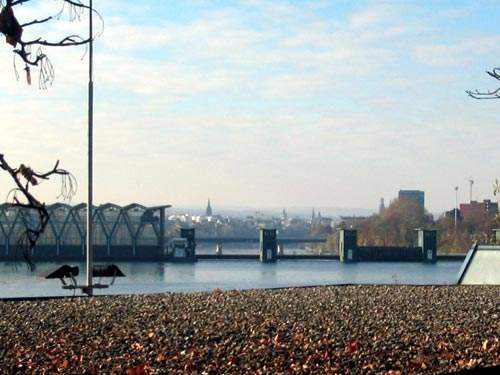A further repowering project has made the Birsfelden hydroelectric plant in the Swiss Basle region fully automatic. The Rhine has also been deepened to increase power output, and waste heat is now being used for district heating. Kraftwerke Birsfelden owns the plant, which has an 80-year concession period.
Commissioned in 1954, the plant has been repowered in three stages. First, the rotor vanes were replaced and the rotor casings and generators renewed (completed in May 1999 for CHF50 million). The Rhine downstream of the power station later had to be deepened (costing CHF30 million). Finally, the power station’s operation was fully automated, with a closed cooling water system to reduce maintenance, more efficient use of waste heat for district heating and the replacement of various subsidiary works (completed in 2000 for CHF20 million).
FOUR KAPLAN TURBINES
The plant as originally erected had four 7.2m-diameter Kaplan turbines, two supplied by Charmilles (now Voest-Alpine MCE of Austria) and two by Sulzer Ravensburg (the Swiss Sulzer Group). These had numerous faults, meaning that each machine had to be taken out of service for eight to ten weeks for biannual refurbishment. Only half of the reactive power of the generators could be used, since the heating of the stator winding had to be strictly limited because of periodic short-circuits in the coil. Since modernisation, the turbines only need refurbishment every five years.
Since 1995, each of the four machines has been modernised consecutively and all are now back in operation. The turbines were each worked on at a time of low river levels to minimise spillage. The first machine took 40 weeks. The second machine was installed more swiftly (36 weeks), possibly because the refurbishment contract gave a profit share of any electricity generated to the contractor. The final machine was operating again by May 1999.
During refurbishment, the rotor casings were radially bored out to a depth of 9mm, and radially re-coated to a depth of 3mm. This increased the intake capacity of the turbine slightly. The automation was handled by the Austrian SAT without any major surprises. Project three was completed at the end of 2000. Since January 2001, the plant has been operating automatically. This reduced the number of staff needed to run the plant from 37 in 1994 to 25 in 2002.
RIVER DEEPENING FOR PLANT EFFICIENCY
The deepening of the Rhine raised environmental concerns which caused delays. The project is still unfinished due to these environmental concerns, and the work is unlikely to restart before 2007.
The plan is to dredge out the river downstream of the power plant by an average of 80cm over a length of 2,087m, which would increase energy production by 4.7%. This is even more than is achieved through modernising the machines.
FIXED PRICES MADE REFURBISHMENT PREDICTABLE
Both the Birsfelden customers and the contractors (for installation and commissioning) had fixed prices, making the refurbishment far more predictable to manage. Asking the contractors to do simultaneous work on a number of sub-projects with short deadlines also cut costs. In return for an offset, the main suppliers were required to recruit 5% to 10% of their tendered installation labour from the Birsfelden staff.
The short-term capital costs of the refurbishment are being repaid by the increased production (up by 4.4%). The extra output will be about 1,000GWh by the end of the plant’s concession in 2034. The plant renewal was also designed to minimise the plant operating costs, including fewer staff.
Most of the project was completed by ABB and Sulzer Hydro (now part of the VA Technologies group and called VA Tech MCE). The automation work was awarded to SAT in Austria, which is also part of the VA Tech Group.







